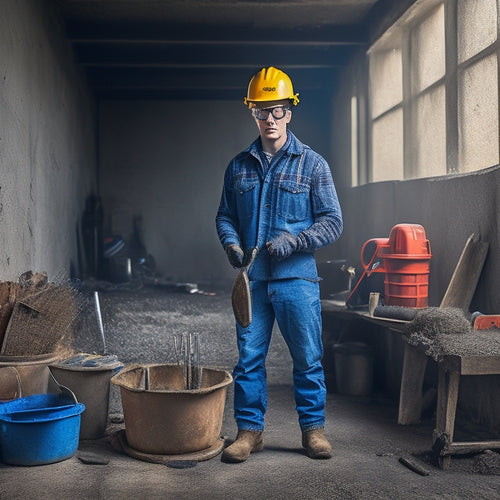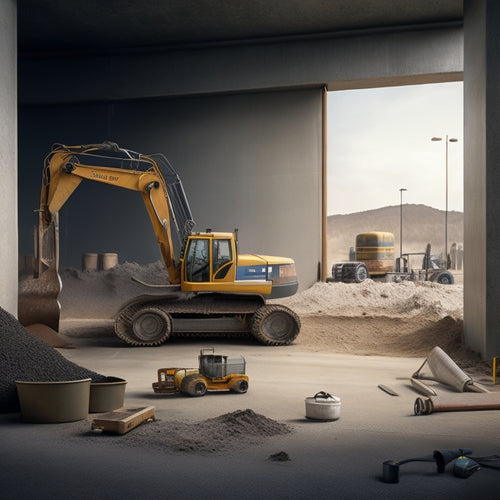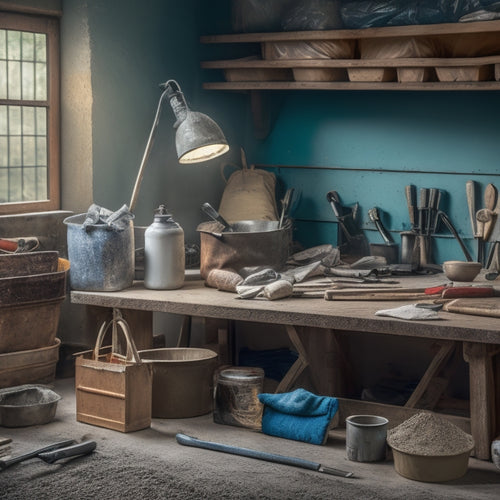
Top Tools for a Polished Concrete Floor Finish
Share
You'll need a combination of specialized tools to achieve a polished concrete floor finish. Start with a high-performance grinding and polishing machine, adjustable for customized grinding processes, and paired with edging and corner tools for seamless finishes in hard-to-reach areas. Don't forget to prepare the concrete floor by evaluating its condition, making necessary repairs, and cleaning the surface. Next, select the right polishing pads and discs based on grit level, bond type, and pad density. Finally, prioritize safety with personal protective gear, including eyewear, gloves, and respirators. Now that you have the essentials, you're ready to reveal the secrets to a truly exceptional finish.
Key Takeaways
• Grinding and polishing machines with adjustable speed controls are essential for achieving a high-gloss finish on concrete floors.
• Edging and corner tools with adjustable handles and rotating heads provide precision and control for hard-to-reach areas.
• Polishing pads and discs must be selected carefully, considering disc materials, grit level, bond type, and pad density for the desired shine and finish.
• Concrete floor preparation tools, including surface cleaners and moisture testers, are necessary for assessing and repairing concrete imperfections.
• Safety gear, such as protective eyewear, gloves, respirators, and steel-toed boots, is crucial for protecting workers from hazardous materials and injuries.
Grinding and Polishing Machines
When preparing to achieve a high-gloss finish, you'll need to invest in a reliable grinding and polishing machine that can efficiently remove surface imperfections and progressively refine the concrete's surface. This machine is the backbone of your floor maintenance routine, and its efficiency directly impacts the quality of your finished product.
Look for a machine with adjustable speed controls, allowing you to customize the grinding process to suit the specific needs of your concrete floor. A machine with a high horsepower motor and aggressive grinding action will help you achieve the desired level of refinement.
Additionally, consider a machine with a built-in vacuum system to minimize dust and debris, ensuring a cleaner and safer working environment. By selecting a high-performance grinding and polishing machine, you'll be able to achieve a flawless, high-gloss finish that will elevate the appearance of your concrete floor and make it easier to maintain.
Edging and Corner Tools
For a professional, high-gloss finish, you'll need to tackle those hard-to-reach areas with specialized edging and corner tools that can effectively polish and refine the concrete's surface, ensuring a seamless changeover between the main floor area and surrounding edges.
When it comes to edging techniques, you'll want to use tools that can get into tight spaces, such as around stairs, pipes, or walls. Edging machines with adjustable handles and rotating heads will give you the precision and control you need to achieve a flawless finish.
Corner finishes require an even higher level of precision, and that's where specialized corner tools come in. These tools are designed to polish and refine the concrete in tight, 90-degree angles, leaving no rough edges or imperfections behind.
To achieve a high-gloss finish, you'll need to use a combination of edging and corner tools in conjunction with your grinding and polishing machines. By investing in the right tools for the job, you'll be able to deliver a professional-grade finish that exceeds your clients' expectations.
With the right edging and corner tools, you'll be able to tackle even the most challenging projects with confidence and precision.
Concrete Floor Preparation
You'll need to assess the condition of the concrete floor and identify any cracks, unevenness, or other imperfections that require repair before proceeding with the polishing process. This step is vital, as any defects can affect the final appearance of the polished floor.
Take note of any cracks or joints that need to be filled, and make sure they're properly repaired and allowed to cure before moving forward.
Next, you'll need to perform surface cleaning to remove any dirt, oil, or other contaminants that may be present on the floor. This can be done using a combination of sweeping, vacuuming, and scrubbing with a degreaser.
It's important to achieve a clean surface to guarantee a strong bond between the concrete and any subsequent coatings or sealers.
Moisture testing should also be conducted to determine the level of moisture present in the concrete. This is critical, as excessive moisture can cause issues with the polishing process or lead to premature wear of the finished floor.
Polishing Pads and Discs
With a properly prepared concrete floor, you can now move on to selecting the right polishing pads and discs to achieve the desired level of shine and finish. This is where the magic happens, and your polishing techniques come into play.
You'll need to choose polishing pads and discs that are compatible with your floor's condition and the level of shine you're aiming for.
There are various disc materials to evaluate, each with its own strengths and weaknesses. Metal-bonded discs are aggressive and ideal for removing imperfections, while resin-bonded discs are better suited for finer polishing. You may also opt for hybrid discs that combine the benefits of both.
When selecting polishing pads, evaluate the grit level, bond type, and pad density. A higher grit level indicates a finer polish, while a lower grit level is better for removing imperfections. The bond type will depend on the floor's condition and the level of shine desired. Pad density affects the polishing speed and finish quality.
Safety and Protective Gear
Wearing the right safety gear and protective equipment is essential when operating polishing machines and handling chemicals, as it shields you from hazardous materials and prevents injuries. You'll need to invest in personal protective equipment (PPE) that meets industry standards to guarantee your safety on the job site.
Here's a breakdown of the essential safety gear you'll need:
| Safety Gear | Purpose | Recommended Option |
|---|---|---|
| Protective Eyewear | Shields eyes from chemical splashes and debris | ANSI-approved safety glasses or goggles |
| Safety Gloves | Protects hands from chemicals and abrasion | Heavy-duty, chemical-resistant gloves |
| Respirator | Filters out airborne contaminants | NIOSH-approved respirator mask |
| Steel-Toed Boots | Protects feet from heavy equipment and falling objects | ANSI-approved steel-toed boots |
| First Aid Kit | Treats minor injuries and wounds | OSHA-compliant first aid kit |
Frequently Asked Questions
Can I Use a Polished Concrete Floor in a Residential Kitchen?
You're considering a polished concrete floor in your residential kitchen, but you're right to have durability concerns. Daily wear and tear from foot traffic, spills, and dropped objects can take a toll.
However, with proper maintenance and sealing, polished concrete can withstand kitchen demands. Plus, its design aesthetics offer a sleek, modern look that complements any style.
How Do I Maintain a Polished Concrete Floor After Completion?
To maintain your polished concrete floor, you'll need to establish a regular cleaning routine and maintenance schedule.
Start by sweeping or vacuuming daily to remove dirt and debris.
Next, mop with a neutral-pH cleaner and warm water.
For more thorough cleaning, use a microfiber mop and a specialized concrete cleaner.
Set a schedule to repeat this process weekly, and consider quarterly deep cleanings to keep your floor looking its best.
Are Polished Concrete Floors Suitable for High-Traffic Areas?
When considering polished concrete floors for high-traffic areas, you'll naturally have durability concerns.
Fortunately, with the right design options, these floors can withstand heavy foot traffic. You can opt for a higher-gloss finish, which is more resistant to scratches and spills.
Additionally, applying a concrete densifier can increase the floor's hardness, making it more suitable for high-traffic zones.
Can I Install a Polished Concrete Floor Over an Existing Floor?
You're wondering if you can install a polished concrete floor over an existing one, and the answer is, it's possible, but beware of the ticking time bomb beneath your feet.
Existing floor suitability is key, as uneven surfaces, cracks, or weak spots can wreak havoc on your new installation.
Be prepared to tackle installation challenges head-on, or risk a finish that's more rough than refined.
Do Polished Concrete Floors Increase a Property's Resale Value?
You're wondering if polished concrete floors boost a property's resale value. The answer is yes.
By installing a polished concrete floor, you're increasing your property's appeal to potential buyers. This unique feature sets your property apart, providing an impressive investment return.
In fact, polished concrete floors can recoup up to 100% of their installation cost at resale, making them a smart investment for savvy homeowners like you.
Conclusion
As you finalize your polished concrete floor finish, remember that 'practice makes perfect.'
With the right tools, including grinding and polishing machines, edging and corner tools, proper concrete floor preparation, polishing pads and discs, and essential safety gear, you'll be well on your way to achieving a showroom shine.
By investing in these top tools, you'll avoid costly mistakes and guarantee a professional-grade finish that will impress clients and leave a lasting impression.
Related Posts
-

What Tools Do I Need for Concrete Wall Repair
As you prepare for a concrete wall repair job, you'll need a variety of tools to guarantee a successful outcome. Star...
-

Why You Need Affordable Concrete Wall Construction Tools
You need affordable concrete wall construction tools to guarantee a profitable project, as the cost of equipment can ...
-

10 Must-Have Tools for Small Concrete Projects
When tackling small concrete projects, you'll need a range of essential tools to achieve professional-grade results. ...


